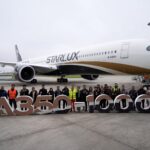The 737 max has come up with yet another problem. After the FAA just reported faulty wing parts in not only the max aircraft but also in some NG aircraft, Boeing is facing some more scrutiny due to the faulty MCAS system.
In the early stages of development Boeing designed version 1 of the MCAS system to nudge the nose down to handle high speed maneuvers smoothly. The system relied on two sensors measuring acceleration or G forces and the relative angle the plane was against the wind. This was to ensure the software didn’t activate erratically and cause a hazardous situation. This was the version that the FAA originally tested and approved as it met all necessary regulatory requirements. The 737 max chief test pilot Ray Craig was satisfied with the system up until his departure from Boeing.
This is until Ed Wilson took over the position of chief test pilot on the 737 max. When he first tested the aircraft he noticed that the plane didn’t handle well when approaching stalls at low speed. He proposed at a Boeing meeting with engineers in Seattle that MCAS should be used to fix the problem. Many didn’t speculate about the change other than how the new system would work on the aircraft. This change meant that Boeing had to remove the G-force factor in the MCAS system as the plane would now need to activate in low speed situations.
Ed Wilson Right, and his co-pilot exit the aircraft after the first test flight. Picture by Elaine Thompson
This change meant that Boeing was going to rely on only one angle of attack sensor with no safeguard if the system was to fail. Older versions of the 737 all use two AOA sensors while the MCAS system relies on one. Because the system needs to operate at a lower speed to avoid stalls the system needed an update. Version one of the system was able to move the stabilizer 0.6 degrees down in 10 seconds while the new version two was able to nose down by 2.5 degrees in just 10 seconds. Engineers at Boeing weren’t aware of the change to the system and when asked about the change most were concerned that Boeing was only using one sensor. The FAA officials weren’t aware of the changes and because of the agencies policies it didn’t require them to look back at the MCAS system’s version two as it didn’t change how the plane would operate in the designated conditions. Earlier on in 2016 Boeing’s chief technical pilot asked the FAA if they could remove the MCAS system from the pilots manual without mentioning the changes they were making to the system. The FAA assumed the system was barely used and was relatively the same so the FAA approved.
Due to Boeing’s claim that the system was relatively the same in all 737 aircraft it didn’t require any extra training on the system. This was also because the system was never tested for a malfunction. Pilots and airlines became increasingly disappointed in Boeing for not disclosing the new system that was implemented. Most said they could’ve lost their life because of this lack of communication and most didn’t understand why Boeing didn’t disclose the information to them. This is just another bump in the road to get the 737 max back in the air. As we mentioned in an earlier article Boeing released a software update to the aircraft to be tested. Those results are currently pending.
Would you feel safe flying on the 737 max in the future? Let us know in the comments below.









